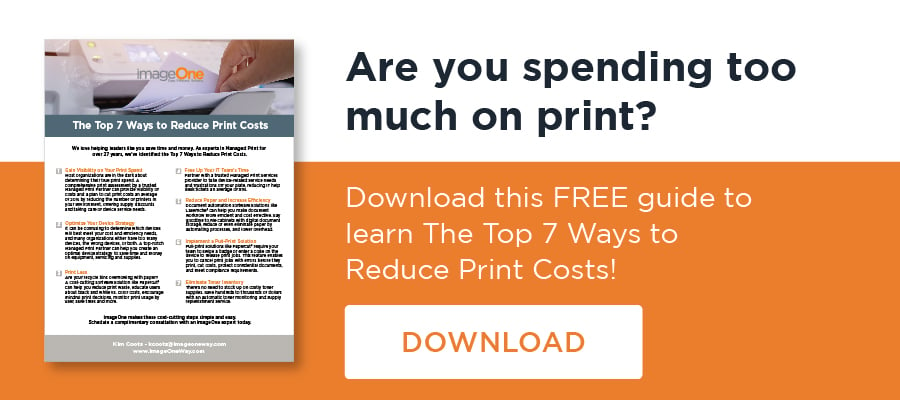Before signing on with a managed print service (MPS), businesses typically want to know how much this new service will cost. However, a final estimate can’t be determined until the MPS provider knows what your business is currently printing, and how that price all adds up.
Since most office print environments contain many complex factors— including devices, print supplies, workflow strategies, and network security features—accurately calculating the print cost is often best left to a managed print expert.
So, how does an MPS team figure out what your company spends on printing and copying? And how does this number factor into what you’ll pay for a high-quality print management service?
What Factors Into Business Print Costs?
The main factors that add up to the final print cost are a combination of the total price of your equipment (often leased for three to five years) and the cost per page, or the CPP. Then, the total volume of black and white pages vs. color pages also integrate into the final formula.
Once calculated, vendors receive an all-inclusive price, which includes all toner, parts, printer supplies, service support, network maintenance—virtually everything needed to support your devices going forward.
How Does an MPS Provider Determine Print Costs?
A managed print service provider determines these costs by thoroughly examining your current print process. Then, they’ll complete an in-depth analysis of your print needs. This includes the number and size of devices, paper volumes, the conditions of the workspace, age of print devices, etc.
The formal analysis process begins when the print management representative visits your location where they’ll install what’s called a data collection agent, or a DCA, to your print and copy devices. The DCA connects to your network and records how many pages are printed over a designated period. This period usually lasts about 30 days.
While on-site, the MPS rep will also survey the current office environment itself. Often, they’ll even map out the building with notes describing where every device currently sits. Once DCA results come back, they’ll also add the current print volumes for each device. 
They’ll also interview various employees to get a better idea of things like how often they use each device, any specific pain points, and which features are most popular.
Once the final results have been compiled, the MPS can analyze this detailed data with confidence. They’ll use their expertise to determine the right print devices for your office as well as accurately calculate the cost per page.
From here, they’ll create a final report to present back to you. This includes details like a side-by-side comparison of your current print environment alongside a vision for your future environment. They’ll also provide a clear picture regarding their new plan to optimize your space, save on print costs, run a more time-efficient business, and deliver exceptional results.
How Long Does the Entire Process Take?
From initial contact to the final estimate, the process of receiving a final print cost typically takes around 45 to 60 days. This timespan takes into account the 30 days needed to accurately gather information from the DCA. Then, the managed print team will need about 2-4 weeks to devise the right pricing and print strategy moving forward.
It might sound time-consuming, but it’s only to ensure clients get the most accurate quotes while devising the perfect strategy for your unique organization.
Calculating Print Costs Without an MPS
Unless you’re well-researched in print device variations, network and data security, workflow strategies, volume tracking, etc., it’d be challenging to accurately calculate an estimated print cost on your own.
By trusting an experienced team that’s well-versed in the intricacies of a managed print environment, you can count on receiving a comprehensive and thoughtful analysis with deep consideration towards cost savings, efficiencies, security measures, future growth, and more.
Also, even if one of your more tech-savvy employees could potentially learn how to calculate your company’s print costs correctly, wouldn’t their valuable time and current skill set be better utilized elsewhere?
Lastly, the entire print environment analysis process is typically free of any charges. Yes. Even after the MPS provider gives you the final report and quote, there’s still zero obligation to sign a contract.
So, what do you have to lose?
Ready to cut back on printing costs and optimize your company’s print environment? Let’s talk! Schedule a 15-minute Discovery Call with our friendly managed print experts and let’s make your printing process better than ever!
Before signing on with a managed print service (MPS), businesses typically want to know how much this new service will cost. Connect with me on Twitter and LinkedIn and keep up with my company imageOne. Check out my website or some of my other work here.




